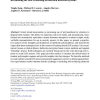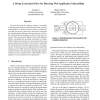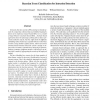46 search results - page 7 / 10 » A Model for the Semantics of Attack Signatures in Misuse Det... |
ML
2010
ACM
13 years 4 months ago
2010
ACM
Current trends demonstrate an increasing use of polymorphism by attackers to disguise their exploits. The ability for malicious code to be easily, and automatically, transformed in...
HICSS
2007
IEEE
14 years 3 days ago
2007
IEEE
e-business organizations are under constant threat of their business being disrupted by hackers, viruses and a host of malicious attackers. This would lead to loses to the tune of...
SEKE
2010
Springer
13 years 4 months ago
2010
Springer
Given the bytecode of a software system, is it possible to automatically generate attack signatures that reveal its vulnerabilities? A natural solution would be symbolically execu...
ISSTA
2012
ACM
11 years 8 months ago
2012
ACM
Over the last decade, there has been a significant increase in the number and sophistication of malware-related attacks and infections. Many detection techniques have been propos...
ACSAC
2003
IEEE
13 years 9 months ago
2003
IEEE
Intrusion detection systems (IDSs) attempt to identify attacks by comparing collected data to predefined signatures known to be malicious (misuse-based IDSs) or to a model of lega...



